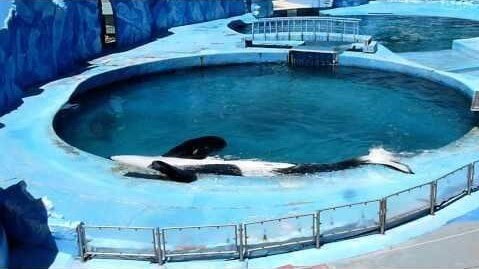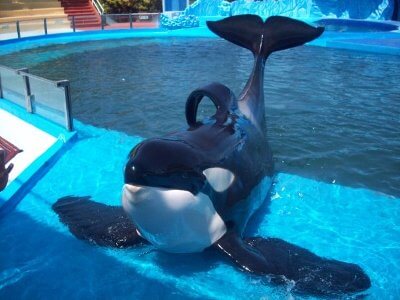Kshamenk: “Rescue” on the Beach

According to Mundo Marino, an amusement park in Buenos Aires, Argentina, Kshamenk (pronounced “Shamenk”) was found by fishermen stranded on a beach along with three other orcas in 1992. By the time the fishermen returned with help, the three other orcas had returned to the ocean. But Kshamenk was seriously dehydrated, unable to move, and in critical condition.
A team organized by Mundo Marino was able to rescue him, bring him to their medical pool, and restore him to health over a period of months. By that time, however, a team of national and international experts declared that returning Kshamenk to the ocean would not be successful and would put his life at risk.
At least, that’s Mundo Marino’s version of what happened.
Animal protection organizations are skeptical of the story. Instead, they suggest, Kshamenk may have been forced ashore by people with an interest in circumventing Argentine laws against the commercial capture of wild marine mammals.
Kshamenk may have been forced ashore by people with an interest in the commercial capture of wild marine mammals.We may never know which version is the truth. What we can say for sure, however, is that keeping Kshamenk on display for public entertainment, just like so many other whales in amusement parks around the world, is absolutely not in his best interest.
Nor was it in his interest to force him to deliver his semen to staff members from SeaWorld, who came to Mundo Marino in order to bring his genetic material back to the United States so they could breed yet more captive whales. It simply doesn’t square with the statement on the organization’s website that “Mundo Marino is an organization focused on conserving wildlife through environmental education projects and strategies, with the aim of helping to generate a more responsible society with the care of the planet.”

Upon the SeaWorld staffers’ return to the United States, the orca Kasatka was artificially inseminated at the company’s San Diego entertainment park, as also was Takara at the San Antonio facility. Kasatka gave birth to Kshamenk’s son, Makani, on February 14, 2013. And Takara, who is Kasatka’s mother, gave birth to Kshamenk’s daughter, Kamea, on December 6, 2013.
For his first eight years at Mundo Marino, Kshamenk had the company of a female whale, Belen, who had been taken from the beach in almost identical circumstances to Kshamenk. Belen became pregnant with his first calf but delivered a stillborn in 1998. She became pregnant again the following year but died while pregnant in 2000. Since then, Kshamenk has been the only orca living at Mundo Marino.
Several attempts were made by animal welfare organizations, including Earth Island Institute (which organized the release of Keiko, the “Free Willy” whale, from an amusement park in Mexico City), to convince Argentine authorities that Kshamenk should be returned to the ocean, but to no avail. And while it is now certainly too late to attempt his return to the ocean, it is by no means too late for Kshamenk to be retired to a seaside sanctuary, where he can live out the rest of his life in a natural environment.
Photos from Dolphin Project